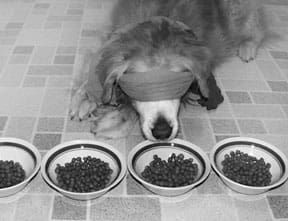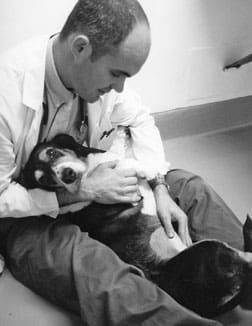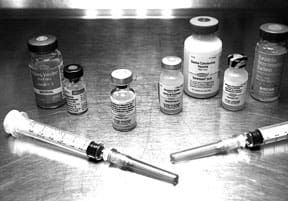[Updated February 23, 2016]
No one is in a better position than you are to decide which food you should feed your dog. That may not be what you wanted to hear. You may have been hoping that someone would reveal to you the name of the world’s healthiest food, so you could just buy that and have it done with.
But dogs, just like people, are individuals. What works for this dog won’t work for that one. A Pointer who goes jogging with his marathon-running owner every day needs a lot more calories than the Golden Retriever who watches TV all day. The diet that contains enough fat to keep that sled dog warm through an Alaskan winter would kill that Miniature Poodle who suffers from pancreatitis. The commercial kibble that stopped my Border Collie’s itching and scratching in its tracks may cause your Bedlington Terrier to develop copper storage disease.
Every food on the market contains different ingredients, and each one has the potential to cause symptoms of allergy or intolerance in some dogs. Every food contains a different ratio of macronutrients – protein, fat, and carbohydrates – and you have to learn by trial and error which ratio works best for your dog. Each product contains varying amounts of vitamins and minerals, and though most fall within the ranges considered acceptable by the Association of American Feed Control Officials (AAFCO), some may be in excess of, or deficient to your dog’s needs.
So how do you choose?
The Starting Place
Well, you have to start somewhere, and you undoubtedly have. Your dog is eating something already. We hope it’s a food that meets WDJ’s selection criteria, which is outlined annually in the February issue. We highlight a number of foods on our “approved” list, but consider any food that meets our selection criteria to be as good as the ones on our list. Our goal is to help you identify the foods with the best-quality ingredients – whole meats, vegetables, fruits, and grains, and high-quality sources of dietary fat – to get you into the right “ballpark” in terms of quality. Then you have to start individualized feeding trials on your dog.
Start by assessing your dog’s health. Take a sheet of paper and make a list with two columns: one for health problems, and one for health assets. Any conditions for which she receives veterinary care or medications go in the “problems” column. Other conditions that should be listed here include bad breath; teeth that are prone to tartar buildup; chronically goopy eyes; infection-prone or stinky ears; a smelly, greasy, flaky, or thinning coat; itchy paws; excessive gas; recurrent diarrhea, constipation, or incontinence; repeated infestations of worms or fleas; low or excessive energy; and a sudden onset of antisocial or aggressive behavior.
In the health assets column, list all the health characteristics that your dog has in her favor, such as fresh breath, clean teeth, bright eyes, clean ears, a lack of itching, a glossy coat, problem-free elimination, a normal appetite and energy level, and a good attitude.
If there are a lot more assets on your list than problems, and the problems are very minor, you may have already found a diet that works well for your dog. But if your list reveals a lot more problems than assets, your dog is a good candidate for a change of diet – in addition to an examination and some guidance from a good holistic veterinarian!
Now take a look at the food you are currently feeding your dog. Note the food’s ingredients, as well as its protein and fat levels, and its caloric content. Write all of this down, so you can make logical adjustments if need be.
Nutritional Management of Disease
Just two decades ago, it was considered fairly radical to propose that canine diseases could be treated, at least in part, by manipulating the patients’ diets. Today, the increasing availability of “prescription” diets is the big story in the pet food industry. As stated by the editors in the preface of the fourth edition (2000) of Small Animal Clinical Nutrition (the nutrition bible for most veterinarians):
“This is truly an exciting time for those involved in the discipline of clinical nutrition because of the veterinary profession’s increased understanding of the role of nutrition in health and disease management, pet owners’ continued interest in receiving the best nutritional information for their pets and the recent proliferation of commercially available therapeutic foods. Our ability to improve the quality of life for pets and their owners is great.”
If your dog has any sort of disease or an inherited propensity for disease, ask your veterinarian about the benefits of nutritional therapy to help treat or prevent the disease. Don’t settle for the suggestion of a commercial “prescription” diet; most of them are formulated with lower-quality ingredients. Instead, ask what specifically in the diet has been manipulated so as to be beneficial for your dog. Then, see if you can find a product that offers the same benefits and better-quality ingredients. The best example is a “kidney” diet for dogs with kidney failure. The goal is to feed these patients a diet with a moderate level of very high-quality protein and low amounts of phosphorus (see “When to Say No to Low-Protein,” WDJ May 2005). An intelligently formulated home-prepared diet can do a far better job of accomplishing these goals than the commercial diets on the market.
You should also do some research on your own to determine what dietary changes might help your dog. A good starting place is Donald R. Strombeck’s Home-Prepared Dog & Cat Diets: The Healthful Alternative (available by order in bookstores, and from www.Amazon.com and www.DogWise.com). Dr. Strombeck details strategies for changing the dog’s diet to treat and/or prevent gastrointestinal, skin, skeletal and joint, renal, urinary, endocrine, heart, pancreatic, and hepatic disease.
Other diseases that can be improved with dietary management include:
• Allergy or intolerance. There are a number of breeds that are particularly susceptible to food allergies, including Cocker Spaniels, Dalmatians, English Springer Spaniels, Labrador Retrievers, Lhasa Apsos, Miniature Schnauzers, and more. Again, it’s important to keep a record of what foods you feed your dog, what they contain, and how your dog looks and feels. If your records indicate that one or more ingredients trigger bad reactions in your dog, seek out foods that do not contain those ingredients in any amount. (See “Walking the Allergy Maze,” August 2004 and “Diet Makes the Difference,” May 2001.)
• Cancer. High-fat, low-carbohydrate (or carb-free) diets are ideal for cancer patients. Cancer cells use carbs for energy, and don’t easily utilize fat, so you can effectively “starve” the cancer cells while providing extra energy to your dog with a diet rich in a high-quality fat sources. (See “Feed the Dog, Starve the Cancer,” November 2003.)
• Inherited metabolism disorders. Some breeds are prone to diseases with a strong dietary influence. For example, the West Highland White Terrier and the Cocker Spaniel have an inherited tendency to suffer from copper buildup in the liver; these dogs should eat a diet that is formulated with low levels of copper. Malamutes and Siberian Huskies can inherit a zinc metabolism disorder, and require a high-zinc diet (or zinc supplements).
Ask your veterinarian (and reliable breeders) about your dog’s breed-related nutritional requirements. And contact the manufacturer of your dog’s food for the expanded version of the food’s nutrient levels. Pet food makers are not required to print the levels of every nutrient on their labels, but should make this information available to you upon request.
Caloric Considerations
Another thing you have to consider is the caloric content of the food you choose. If the food you select for your dog is energy-dense, and your dog is a couch potato, you may have to cut her daily ration considerably to prevent her from getting fat. Some dogs respond to forced dieting with begging, counter-surfing, and garbage-raiding. If your dog is one of these, you may have to seek out a high-fiber, low-calorie food – one that may not necessarily contain the highest-quality protein or fat sources on the market – to keep your dog feeling contentedly full without getting fat.
Dogs exhibit a wide range of energy requirements. You may have to seek out a higher- or lower-calorie food based on the following attributes that can affect your dog’s energy needs:
• Activity level. The more a dog exercises the more energy he needs to consume to maintain his condition; it’s that simple.
• Growth. Growing puppies have higher energy requirements than adult dogs. A food with a higher protein level, but a moderate (not high) fat level is ideal. Obese puppies are far more prone to degenerative joint disease – especially in large and giant breeds – than puppies with a normal or slim physique.
• Age. The age at which a dog becomes a senior citizen varies from breed to breed, with larger dogs considered geriatric at earlier ages. Older dogs typically require fewer calories to maintain their body weight and condition, partly because they tend to be less active than younger dogs.
• Environmental conditions. Dogs who live or spend much of their time outside in severe cold temperatures need from 10 percent to as much as 90 percent more energy than dogs who enjoy a temperate climate. The thickness and quality of the dog’s coat, the amount of body fat he has, and the quality of his shelter have direct effects on the dog’s energy needs.
• Illness. Sick dogs have increased energy needs; it takes energy to mount an immune response or repair tissues. However, dogs who do not feel well also tend to be inactive, which lowers their energy needs.
• Reproduction. A pregnant female’s energy requirement does not increase significantly until the final third of her pregnancy, when it may increase by a factor of three.
• Lactation. A nursing female may require as much as eight times as much energy as a female of the same age and condition who is not nursing.
• Neutering. It is generally accepted that neutered (and spayed) dogs have reduced energy needs. However, there are actually no studies that conclusively prove that neutered dogs require fewer calories simply as a result of lower hormone levels. It has been suggested that these dogs gain weight due to increased appetites and/or decreased activity levels.
• Other individual factors. Other factors that can affect a dog’s energy requirement include its temperament (nervous or placid?) and skin, fat, and coat quality (how well he is insulated against weather conditions).
Human Factors
Finally, there are the human factors that may influence your dog-food purchasing decision, such as cost and local availability. Understand that there is a connection between the quality of an animal’s food and his health, and do the best you can do.
It’s also worth considering the reliability, responsiveness, and availability of the manufacturer’s customer service people. It can be frustrating and costly if a company makes terrific food, but you can never reach them, your direct-ship order is regularly late, or the customer service people are either rude or unhelpful. Today, there are too many companies doing a good job and making good food to put up with this.














